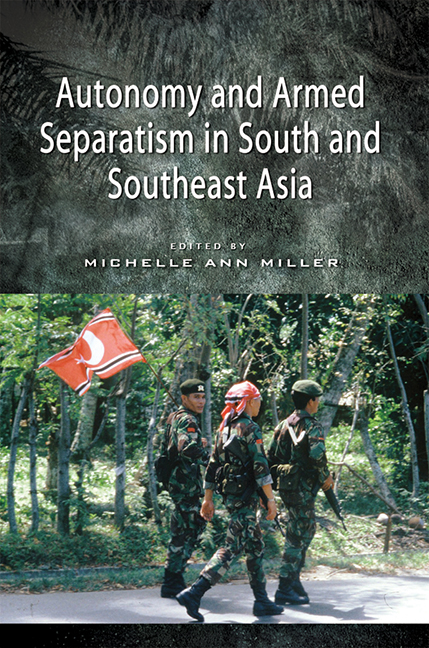Book contents
- Frontmatter
- Dedication
- Contents
- Acknowledgements
- About the Contributors
- 1 The Problem of Armed Separatism: Is Autonomy the Answer?
- 2 Mediated Constitutionality as a Solution to Separatism
- 3 Self-Governance as a Framework for Conflict Resolution in Aceh
- 4 Autonomy and Armed Separatism in Papua: Why the Cendrawasih Continues to Fear the Garuda
- 5 The Parallels and the Paradox of Timor-Leste and Western Sahara
- 6 Between Violence and Negotiation: Rethinking the Indonesian Occupation and the East Timorese Resistance
- 7 Struggle over Space in Myanmar: Expanding State Territoriality after the Kachin Ceasefire
- 8 Sri Lanka's Ethnic Conflict: The Autonomy-Separation Dialectic
- 9 Unitarianism, Separatism and Federalism: Competing Goals and Problems of Compromise in Sri Lanka
- 10 Autonomy and Armed Separatism in Jammu and Kashmir
- 11 Armed Conflicts and Movements for Autonomy in India's Northeast
- 12 Southern Thailand: The Trouble with Autonomy
- 13 The Last Holdout of an Integrated State: A Century of Resistance to State Penetration in Southern Thailand
- 14 Interlocking Autonomy: Manila and Muslim Mindanao
- 15 History, Demography and Factionalism: Obstacles to Conflict Resolution through Autonomy in the Southern Philippines
- 16 Conclusion
- Index
15 - History, Demography and Factionalism: Obstacles to Conflict Resolution through Autonomy in the Southern Philippines
Published online by Cambridge University Press: 21 October 2015
- Frontmatter
- Dedication
- Contents
- Acknowledgements
- About the Contributors
- 1 The Problem of Armed Separatism: Is Autonomy the Answer?
- 2 Mediated Constitutionality as a Solution to Separatism
- 3 Self-Governance as a Framework for Conflict Resolution in Aceh
- 4 Autonomy and Armed Separatism in Papua: Why the Cendrawasih Continues to Fear the Garuda
- 5 The Parallels and the Paradox of Timor-Leste and Western Sahara
- 6 Between Violence and Negotiation: Rethinking the Indonesian Occupation and the East Timorese Resistance
- 7 Struggle over Space in Myanmar: Expanding State Territoriality after the Kachin Ceasefire
- 8 Sri Lanka's Ethnic Conflict: The Autonomy-Separation Dialectic
- 9 Unitarianism, Separatism and Federalism: Competing Goals and Problems of Compromise in Sri Lanka
- 10 Autonomy and Armed Separatism in Jammu and Kashmir
- 11 Armed Conflicts and Movements for Autonomy in India's Northeast
- 12 Southern Thailand: The Trouble with Autonomy
- 13 The Last Holdout of an Integrated State: A Century of Resistance to State Penetration in Southern Thailand
- 14 Interlocking Autonomy: Manila and Muslim Mindanao
- 15 History, Demography and Factionalism: Obstacles to Conflict Resolution through Autonomy in the Southern Philippines
- 16 Conclusion
- Index
Summary
The conflict between the government of the Philippines and the Moro separatists in the southern Philippines has become one of the longest running, and most intractable, internal conflicts in Southeast Asia. This is so despite attempts by successive Philippine governments to negotiate some form of autonomy arrangements with the separatists. This paper briefly reviews the Philippines experiments with Muslim autonomy and addresses the question: why have the autonomy negotiations between the Philippine government and the Moros proved so intractable? It suggests that the answers lie primarily in three features of the Philippines situation: first, longstanding historical circumstances which have left a legacy of antipathy and distrust between important elements of the Muslim and Christian Filipino communities; secondly, a pattern of internal migration, encouraged by national governments throughout the twentieth century, which has changed the ethnic demography of Mindanao and Sulu, locking both sides into a position from which it has been difficult to progress to a settlement; and thirdly, the factionalization of Philippine Muslim society, which has made negotiation difficult.
THE LONG VIEW: A BRIEF HISTORY OF MORO SEPARATISM THE ORIGINS OF MORO IDENTITY
The origins of Moro identity
The basis for the Muslim claims to a separate identity, and arrangements for recognizing the special status of Philippine Muslims, have a long history. When the Spanish colonizers came to the Philippine islands in 1565 and encountered Islamic communities, they effectively resumed the crusades against those they identified as the “Moro”, using the Christianized “indios” as their footsoldiers. But although they defeated Muslim forces in the north, and encouraged Christianized Filipinos to settle on the northern and eastern coasts of Mindanao, the Spaniards never did achieve effective sovereignty over the Muslim (or over much of the tribal/lumad) communities in Mindanao and Sulu.
In 1898, following the Spanish-American War, the United States took possession of the islands of Mindanao and Sulu. Under American colonial rule, once “pacification” had been achieved a general policy of “benevolent assimilation” was extended to the Muslim population, though this was resisted by Muslim communities, as well as by some of the more enlightened American administrators.
- Type
- Chapter
- Information
- Autonomy and Armed Separatism in South and Southeast Asia , pp. 278 - 295Publisher: ISEAS–Yusof Ishak InstitutePrint publication year: 2012

